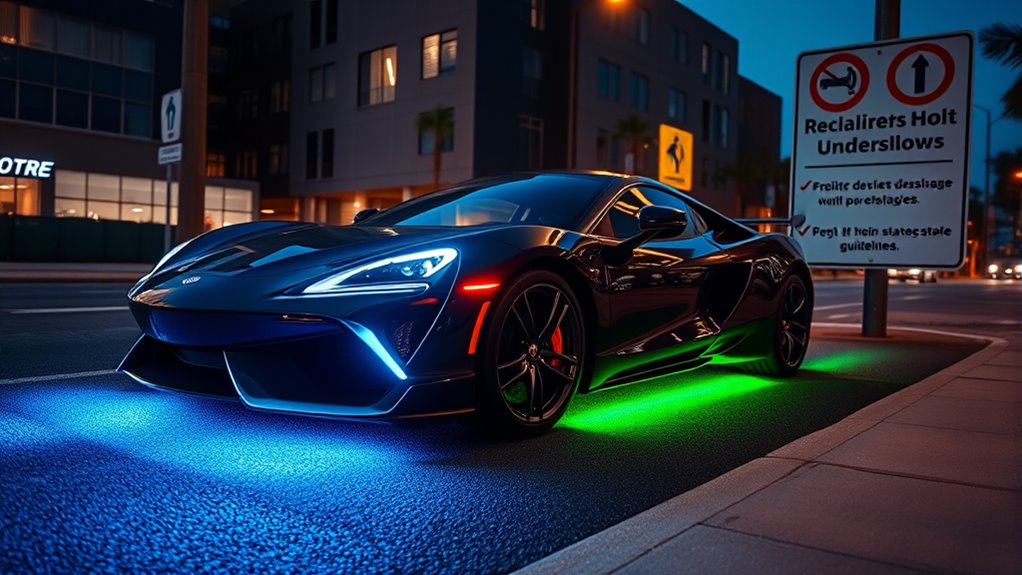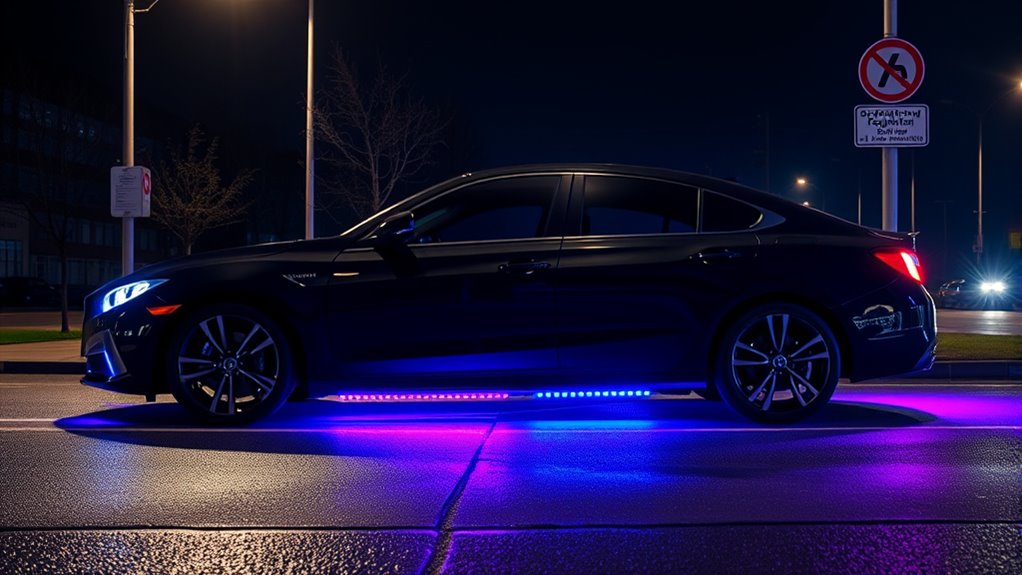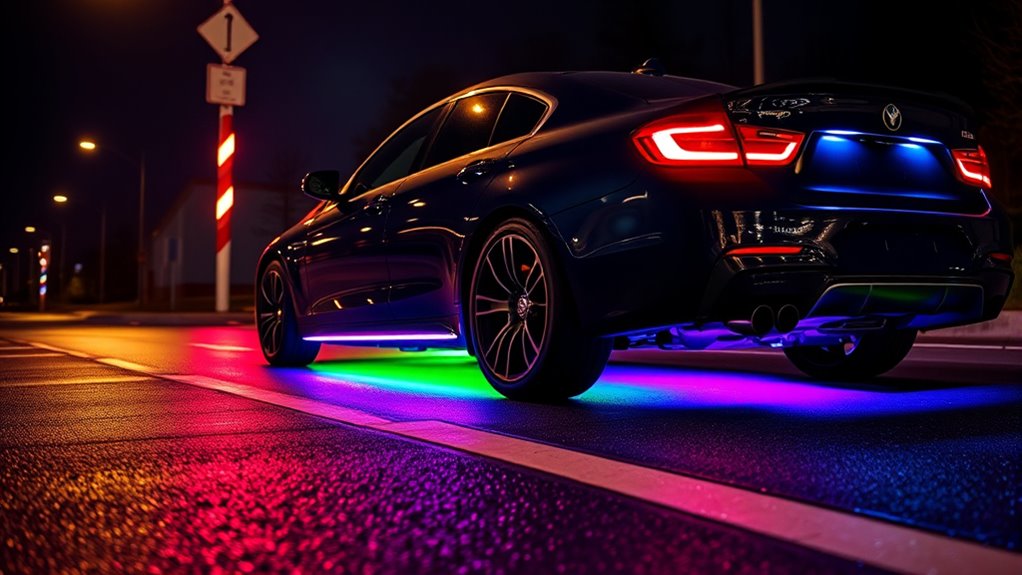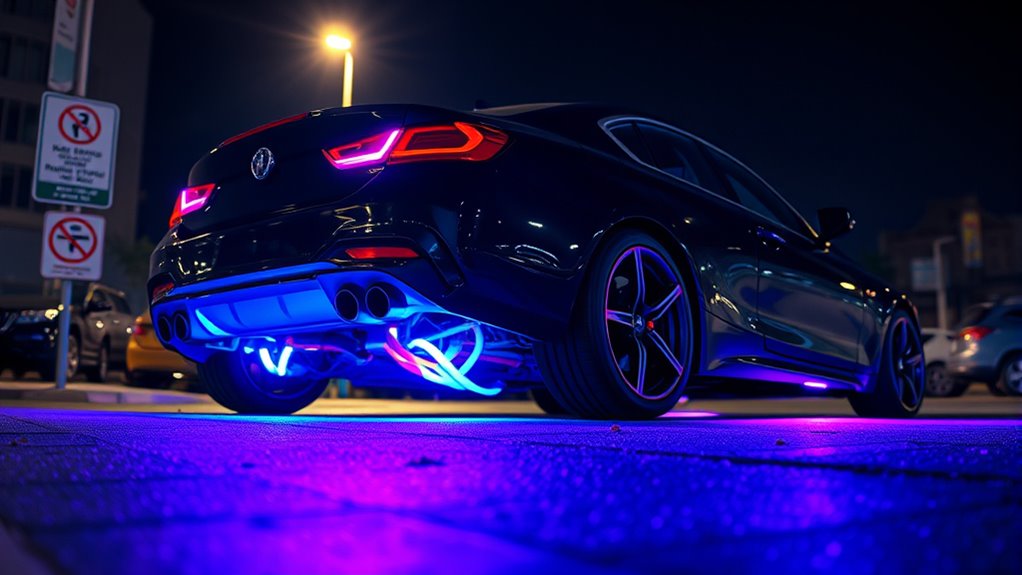Underglow lighting laws vary by state and local jurisdictions, so you need to check your area’s specific regulations. Many places allow certain colors like white, amber, or yellow, but ban red, blue, or flashing lights to prevent confusing emergency vehicles. Failing to follow these rules can lead to fines, tickets, or vehicle modifications. Staying informed about your local laws helps you avoid penalties and keep your vehicle legal—if you want to learn more, keep exploring the details.
Key Takeaways
- Regulations on underglow lighting vary by state; there is no federal law governing these lights.
- Most states restrict colors to non-flashing white, amber, or yellow; red and blue are often prohibited.
- Violations generally result in civil infractions, fines, and “fix-it” tickets requiring modifications.
- Flashing or rotating effects are usually illegal outside emergency vehicle lighting standards.
- Always check local and state laws, HOA rules, and law enforcement guidance to ensure compliance.
Overview of Underglow Lighting Laws

Have you ever wondered what the laws say about underglow lighting on vehicles? Laws vary from state to state, so there’s no single federal rule. Typically, regulations focus on safety and preventing confusion with emergency vehicles. Underglow lights are often classified as minor infractions or misdemeanors, depending on where you are. Infractions can result in fines or penalties, especially if you’re caught repeatedly. While some see underglow as a way to enhance visibility, others worry it’s a distraction to other drivers. Enforcement is handled locally, with law enforcement agencies applying state-specific rules. Vehicle owners must ensure their lighting complies to avoid citations, fines, or impacts on insurance. Staying informed about your state’s laws helps you enjoy customization safely and legally, and understanding vehicle lighting regulations can prevent unintended violations. Additionally, some jurisdictions may allow certain colors or placements for underglow lights, so checking local lighting laws is essential. Consulting local vehicle regulations can help clarify what is permitted and what is not, reducing the risk of penalties. Being aware of underglow light restrictions can also help you plan modifications that stay within legal limits. Moreover, awareness of recent regulatory updates can help you stay ahead of evolving laws and avoid unintentional infractions.
State-Specific Regulations and Permitted Colors

Understanding the specific regulations and permitted colors for underglow lighting varies by state, so it’s essential to know the rules in your area before customizing your vehicle. Here’s what you need to know:
Regulations for underglow colors vary by state; check local laws before customizing your vehicle.
- California: Only white and amber are allowed when non-flashing and front-facing; red and blue are prohibited. High CQ in understanding local laws can help prevent inadvertent violations.
- Arizona & Kansas: Amber and white side lights are permitted; red and flashing lights are banned. Staying informed about cultural norms and regulations ensures responsible customization.
- New York & South Carolina: Only non-flashing white lights are allowed; red and blue are banned.
- Florida & Texas: Florida permits non-blinding colors; Texas regulates intensity and color, allowing most options. Being aware of regulatory compliance and potential restrictions can help avoid penalties.
- Additionally, some states incorporate sustainable materials into vehicle accessories, emphasizing eco-friendly choices in customization. Recognizing local law enforcement practices can also assist in maintaining compliance.
Always check local laws or law enforcement to verify your underglow complies, preventing fines or vehicle impoundment.
Legal Implications of Non-Compliance

Ignoring local regulations on underglow lighting can lead to significant legal consequences. These violations are classified as civil infractions, similar to non-moving traffic violations, and are enforced by local authorities. If caught, you may face fines, additional fees, or a “fix-it” ticket requiring you to remove or modify your lights. Failing to respond to a citation can result in a default judgment, increased penalties, or even a license suspension in severe cases. You have options to admit responsibility, contest the violation, or explain your situation, but ignoring the citation risks escalating consequences. Beyond fines, non-compliance can harm your driving record, increase insurance premiums, and lead to community restrictions. Staying compliant helps you avoid legal trouble and potential future restrictions. Additionally, regulatory compliance ensures your vehicle remains within legal standards and avoids unnecessary penalties. Maintaining awareness of local lighting laws can prevent inadvertent violations and legal issues. Understanding vehicle modification regulations is crucial to ensure your underglow setup adheres to all legal requirements. Proper knowledge of local ordinances can further assist in avoiding unintended infractions and penalties. Being informed about enforcement practices can help you understand how authorities monitor and enforce lighting regulations effectively.
Safety Concerns and Best Practices

To guarantee safe and effective use of underglow lighting, it’s essential to follow best practices when installing and operating them. First, ensure lights are securely mounted to prevent loosening, especially in harsh conditions. Second, choose only approved colors like white, amber, or yellow to avoid confusing other drivers or emergency responders. Third, stick to static lighting; avoid flashing or rotating effects that can distract or impair night vision. Fourth, position lights carefully to prevent glare directed at other drivers, reducing potential hazards. Additional tips include checking local regulations beforehand and maintaining the lights regularly to prevent wear and electrical issues. Moreover, understanding effective fraud prevention tools can help merchants protect transactions from unauthorized access, ensuring safety in digital environments. Also, regularly inspecting the electrical connections and grounding of the underglow lights can prevent electrical hazards, enhancing overall safety. Considering lighting regulations in your area can also help you stay compliant and avoid penalties. By following these guidelines, you can enjoy the aesthetic benefits without compromising safety on the road.
Ensuring Compliance With Local and State Ordinances

Before installing underglow lights, it’s important to make certain your setup complies with local and state laws. Verify if your state bans underglow altogether—Connecticut, Illinois, Maine, Massachusetts, Michigan, Minnesota, Pennsylvania, Virginia, and Washington do. Even in legal states, restrictions on colors may apply; for example, red and blue are often prohibited to avoid mimicking emergency vehicles. Check for specific rules, like Arizona’s allowance of amber and white or Kansas’s ban on red and flashing lights. Avoid flashing or strobe effects, which are universally illegal outside emergency vehicles. Local ordinances and HOA rules may impose stricter limits, so consult city or county authorities. Regularly review regulations, and consider professional installation to ensure your lights don’t obstruct factory lighting or violate placement laws. Staying informed about vehicle lighting regulations can help you adapt to evolving legal standards regarding vehicle modifications. Additionally, being aware of electric bike power and speed regulations can prevent unintentional violations when customizing your vehicle. Moreover, understanding the Private Placement Equity Markets landscape can assist in making informed decisions about alternative investment opportunities. To stay compliant, periodically check for updates on lighting laws in your area, as regulations can change over time.
Frequently Asked Questions
Can I Install Underglow Lights on Commercial Vehicles?
You wonder if you can install underglow lights on your commercial vehicle. Generally, yes, but it depends on your state’s laws. Many states allow certain colors like white or amber, but restrict red and blue to avoid confusion with emergency vehicles. You should check your local regulations for specific restrictions on placement, brightness, and flashing modes. Always guarantee the lights don’t interfere with your vehicle’s visibility or distract other drivers.
Are There Restrictions on Underglow Brightness Levels?
So, you’re curious if underglow brightness has limits? Well, in most places, you’re pretty much on your own—no nationwide rules here. Some states, like Vermont and Arizona, keep tabs on glare or brightness, while others focus on colors or flashing. Basically, if you want to avoid tickets, keep your glow subtle, avoid flashing, and check your local laws. Brighter isn’t always better—just more likely to get you pulled over.
How Often Do Underglow Laws Get Updated?
You’re wondering how often underglow laws change. These updates happen irregularly, driven by safety concerns, new tech, or legal challenges. State legislatures rarely revise laws on a set schedule, and updates often come after enforcement patterns or court rulings. Sometimes, neighboring states align their rules, but overall, changes are sporadic, making it hard to predict when you’ll see new regulations or restrictions.
Do Underglow Laws Differ for Electric Versus Gas Vehicles?
They say “the rules are the same for everyone,” and that’s true here. You won’t find underglow laws changing based on whether your vehicle is electric or gas-powered. The regulations focus on the vehicle’s class and the color, placement, and intensity of the lights. No matter your fuel type, you’re held to the same standards, so stay compliant to avoid fines or penalties.
Is Online Installation Guidance Compliant With Local Regulations?
You should always verify that your online installation guidance aligns with local laws before proceeding. Check your state and local regulations, as they can vary widely. Follow professional advice and use legally approved products. Be aware that some areas restrict certain colors or flashing lights. Staying informed helps you avoid fines or penalties, ensuring your underglow setup is both stylish and compliant with all applicable rules.
Conclusion
So, next time you’re tempted to light up your ride like a nightclub on wheels, remember: the law’s got your back… or at least your wallet. Ignoring regulations might make your car stand out, but it also makes you stand out in court. Play by the rules, and you’ll keep your shine on the road, not behind bars. After all, who needs underglow when you can shine with legal brilliance instead?










